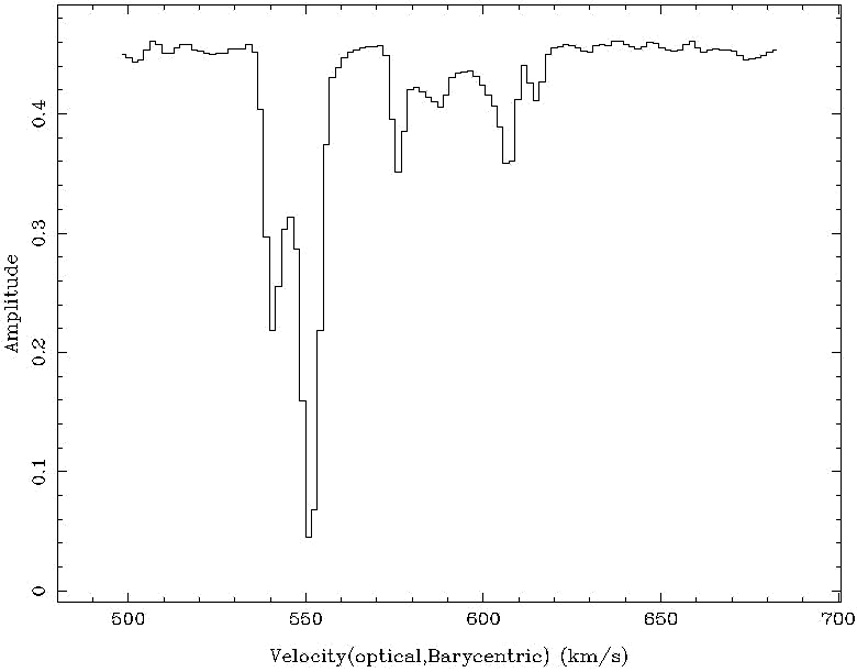Workshop report: millimetre science with the upgraded ATCA
In anticipation of the completion of the ATCA millimetre-wave upgrade in mid-2003, and the availability of a three-element prototype system this coming winter, a workshop on millimetre science was convened at the University of Melbourne on 29-30 November 2001. Participants from the Australian astronomical community, as well as guests from overseas, came to discuss and learn about areas of science that could be addressed with the new ATCA. The speakers have kindly given permission for their viewgraphs to be made available on the web at http://www.atnf.csiro.au/whats_on/workshops/mm_science2001 .
The workshop began with an overview of the prototype system (three antennas with dual polarisation receivers and limited frequency coverage) by Tony Wong, and a presentation of first 3-mm science results by Bärbel Koribalski. One of the highlights was the absorption spectrum of Centaurus A in the HCO+ line (Figure 1), where the spatial filtering provided by the interferometer yields a much cleaner spectral baseline than has been possible with single-dish observations. Other ATNF staff members who gave talks were Dick Manchester, who presented the first image of SN 1987A's remnant at 12-mm, Bob Sault, who reviewed progress on water vapour radiometry, and Warwick Wilson, who discussed plans for a wide-bandwidth correlator.

Figure 1: The ATCA absorption spectrum of Centaurus A in the HCO+ line.
The first two topical sessions focused on the interstellar medium (ISM) and star formation, subjects that by themselves could occupy entire conferences! Although the existing millimetre arrays have made vast strides in these areas, millimetre studies of star-forming regions in the southern skies have lagged far behind infrared studies as a result of the poor angular resolution of millimetre telescopes. The excellent sensitivity and resolution of the ATCA will make it a very competitive instrument for studying protostars and protoplanetary disks, especially once its continuum bandwidth has been upgraded. Two of our invited speakers, Geoff Blake (Caltech) and Tyler Bourke (CfA), outlined several key areas in which ATCA observations can make a significant contribution to our understanding of star formation and young stellar objects. Cornelia Lang (University of Massachusetts) showed us that in the highly energetic Galactic Centre region, molecular gas seems to play multiple roles: forming massive stellar clusters, tracing magnetic field lines, and feeding a massive black hole.
Millimetre spectroscopy is a rich and rapidly growing field, given the large number of molecular lines in this part of the spectrum. Several speakers, including Maria Hunt (UNSW), Robert Smith (UNSW@ADFA), and Mark Wardle (Sydney University), discussed the potential for probing the physical and chemical properties of the ISM using molecular lines. We also heard a great deal about methanol masers from Vincent Minier (UNSW), Andrej Sobolev (Ural State University), and Dinah Cragg (Monash). These masers, which occur at various frequencies throughout the 3-mm and 12-mm bands, appear to trace the early stages of massive star formation, although their excitation mechanisms remain a subject of active research. Indeed, it was clear that much remains to be learnt from millimetre lines other than the ubiquitous CO line, which is a good thing considering that the frequency coverage of the ATCA may not extend up to the CO (1-0) line at 115 GHz.
We rounded out the workshop with a few talks on extragalactic science. Steve Curran (UNSW) presented some of his thesis work on molecular gas in galaxy nuclei as observed with the SEST, emphasising the desirability of higher-resolution datafor example, to confirm the presence of molecular outflows. Tommy Wiklind (Onsala) reviewed searches for molecular gas at high redshift, important for unravelling the star formation history of the universe and obtaining redshifts for submillimetre-detected objects. While CO emission is difficult to detect except in nearby or lensed sources, absorption in the CO or HCO+ lines can be observed out to high redshift by ATCA, as long as a suitably bright continuum source exists. Continuing the theme of quasar absorption lines were presentations by Rachel Webster and Michael Drinkwater (Melbourne University) on searching for molecular gas in front of dust-reddened quasars, and Michael Murphy (UNSW) on using CO absorption lines to detect changes in the fine-structure constant with redshift.
As is inevitable with such a small meeting, many areas could not be properly represented, including, among other things, cosmology, solar system science, extragalactic megamasers, and polarimetry. Hopefully these omissions can be rectified at the next millimetre workshop! In the meantime, we encourage ATCA users to learn more about the millimetre systems by following the links to the 3-mm and 12-mm pages at http://www.atnf.csiro.au/observers/manuals.html , and to consider applying for observing time this year. Also, look for a (longer) summary of the workshop, as well as several papers by invited speakers, in an upcoming issue of PASA.
The principal organisers (myself and Andrew Melatos of Melbourne University) would like to thank the staff and students of Melbourne University for helping to make the workshop a success. We particularly enjoyed the excellent catered meals and the souvenir mugs. We also appreciate the generosity of the MNRF International Collaboration Committee, which helped to support the travel costs of many of our visitors.
Tony Wong
(Tony.Wong@csiro.au)
